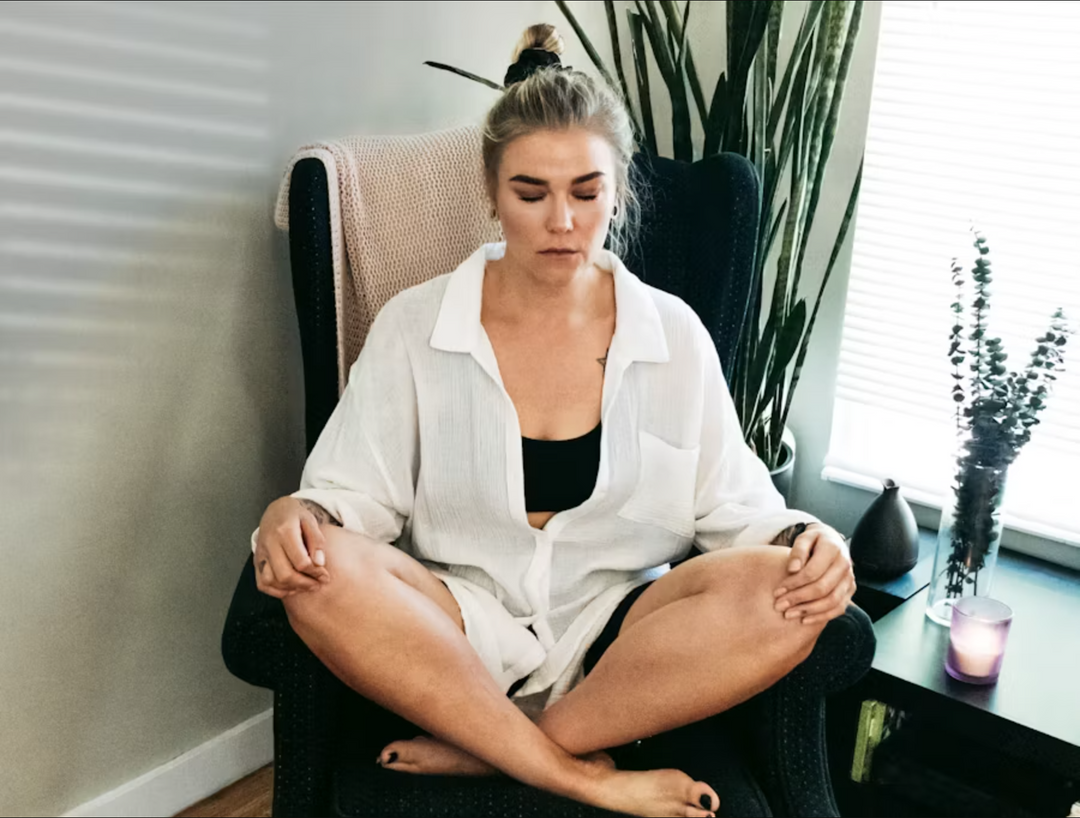Sleep apnea is a common condition, with 22 million Americans estimated to be sufferers. There are a number of methods of dealing with apnea, but, if you’re like me, the natural way is always the best. Yoga is a fantastic natural method for improving your sleep quality.

How Can I Fix Sleep Apnea Naturally?
There are a number of sleep apnea treatments that are natural to consider before looking at more drastic methods.
- Lose Weight/ Maintain a healthy weight. Each unit increase in BMI leads to a 14% increased risk of developing sleep apnea, and just a 10% weight gain increases the risk of sleep apnea by 6 times.
- Altering Your Sleeping Position. It’s a small change overall, but can have radical effects. For adults, the supine position (sleeping on your back) can lead to worsened symptoms, and a switch to sleeping on your side can return breathing back to normal. For children, sleeping on their backs was found to be OK.
- Avoid alcohol and smoking. Alcohol relaxes your throat muscles that dictate your breathing. This can lead to snoring, an interrupted sleep cycle, and inflammation in your airways, blocking your airflow. Smoking can have similar inflammatory effects, and muscle relaxation effects, but also effects further down the coronary system in the lungs, leading to other breathing issues.
- Exercise more, especially yoga. Exercise and keeping fit is an excellent way to keep in shape, and avoid all manor of health complications. A fit body tends to do what it is supposed to do. Yoga especially offers poses and workouts that can open the airways and lead to exceptional sleep.
Sleep Apnea Exercises
Breathing Exercises for Sleep Apnea

Sleep apnea occurs when breathing repeatedly stops and starts. So naturally, breathing exercises are a vital part of fixing sleep apnea. There’s a breathing apparatus known as IMST that works like a straw to suck on, that has a machine on the other end that also sucks back. Studies have suggested that 30 inhalations a day on this machine leads to no symptoms of sleep apnea at night!
Tongue Exercises for Sleep Apnea
Tongue Slides: push the tip of your tongue against the roof of your mouth, and slide the tongue backwards, and repeat until you have done this 20 times.
The “Tiger Yell”: open your mouth as wide as possible so you look like a tiger about to yell. Then push your tongue out as far as you can as if you are going to lick your chin.
Throat Exercises for Sleep Apnea
SINGING! Science suggests that by singing each day for 3 months, improvements in sleep apnea become present.
Soft Palate Blowing: open your mouth as wide as you can, and then inhale through your nose, then exhale gently through your mouth with lips pressed together. This exercise doubles up as a great way to reduce cramps or lactic acid pain during workouts too.
Yoga For Sleep Apnea
One of the best natural methods for fixing sleep apnea is yoga. Yoga is so great for many things, and sleep apnea is no exception.
Can Yoga Cure Sleep Apnea?
Yoga breathing can help strengthen upper airway muscles. People who practise yoga report feeling more energised, and better rested at nights. This is also true for over 60s who suffer from insomnia. One of the causes of bad sleep, or even sleep apnea, can be stress related. Exercise helps to alleviate stress, so yoga as an exercise can help to cure sleep apnea. Studies show that adults who exercise for 5-7 hours per week versus 0-2 hours per week have reduced risks of sleep apnea.
Best Yoga for Sleep Apnea?
First, and probably most importantly, practising yoga at least once a day will help with sleep apnea. This is one of the best remedies for all manner of things; stress, mental illness, common cold amongst many others. There are many poses perfect in helping sleep apnea, but even just by simply exercise with yoga, and practising breathing, can have a significant impact on your sleep.
Yoga Poses, Exercises for Sleep Apnea
1. Cat Cow

To start this pose, you need to get on your hands and knees. Keep your knees in line with your hips and wrists; your elbows and shoulders should be perpendicular to the floor. As you inhale, slowly round your spine toward the ceiling. Drop your head toward the floor, mimicking the shape of a frightened cat. Hold that pose for one second. Next, exhale and return to starting position. Now, Inhale and lift your chest and tailbone to the ceiling as you curve your back down. Raise your head. Hold that pose for 1 second. Repeat these motions 5 to 10 times.
2. Seated Forward Bend

Begin this pose in a seated position and extend your legs straight out in front of you, making sure not to bend at the knees. Sit up with your back straight. As you inhale, reach your arms overhead. Exhale as you fold forward and reach for your toes. Hold that position for 10 seconds. Return to start. Repeat. This position is excellent for doing a couple of things – lengthening your spine, and getting air all throughout your coronary system and lungs.
3. Seated Twist

To start this pose, sit in a cross-legged position. Exhale and place your right hand on your left knee. Place your left hand behind your tailbone. Twist your torso to the left, gently, as you look over your left shoulder. Hold that position for 10 seconds. Return to start, then repeat on the opposite side. This pose works in a few ways. It strengthens your core muscles and your diaphragm, enabling you to both breathe more easily, and intake more oxygen with each breath.
4. Locust Pose

To begin this pose, lie belly down on the floor, arms long along your sides, and palms on the floor. Legs should be long and pointed at the toe. As you inhale deeply, raise your chest and legs up off the floor as much as you can, while keeping your shoulders back and opening your chest. Try to lengthen your spine and keep your neck aligned by imagining watching a marble rolling up and down the floor. Squeeze your glutes and your legs together. Hold this position for a count of three, then relax. Repeat this move for eight to 10 reps.
5. Camel Pose

Take a kneeling position on your mat and support the body on the knees and toes (toes bent). Slowly, lean backwards, and take your arms behind. Fix the palms of your hands to the ground, pointing your fingers outwards and your thumb towards your toes. Keep your arms straight, eyes open, and fix them on a point on the ceiling. Inhaling, slowly lift your pelvis and push your body above the waist, outward and upward. Allow your neck to fall backwards gently. Complete the first two steps in 3 seconds, while inhaling.
6. Roaring Lion Pose

Start by inhaling deeply through your nose. Open your mouth wide, stick out your tongue as far as possible, and exhale strongly, and deeply contracting the abdominal muscles and the pelvic floor. At the same time, roll your eyes up and focus at the center between your eyebrows. Engage your entire body by lifting slightly off your heels as you push your hands into your knees, fingers spread. This pose works well on both the throat muscles and the airways allowing for increased airflow.
Yoga Breathing Exercises for Sleep Apnea

Start by sitting up straight and open, making sure your spine is as straight as possible. Bring your right hand up to your face. Rest your index and middle fingers on your eyebrow. Close your eyes and take a deep breath in and out through your nose. Close your right nostril with your right thumb. Inhale through the left nostril slowly and steadily. Close the left nostril with your ring finger so both nostrils are held closed; retain your breath at the top of the inhale for a brief pause. Open your right nostril and release the breath slowly through the right side; pause briefly at the bottom of the exhale. Inhale through the right side slowly. Hold both nostrils closed (with ring finger and thumb). Open your left nostril and release breath slowly through the left side. Pause briefly at the bottom.
Kundalini Yoga for Sleep Apnea
Kundalini yoga is the coming together of the practises of Bhakti yoga (the yogic practice of chanting), Raja Yoga (the practice of meditation and physical or mental control), and Shakti Yoga (the expression of power and energy). A great kundalini yoga session will leave you feeling like you’ve had a great gym workout, had miracle session with your therapist, and sung your heart out at a concert of your favourite artist!
Given these combined techniques, kundalini can be great for combatting sleep apnea. I’ve already discussed how singing out loud and opening your airways is a great way to prevent many of the symptoms of sleep apnea, but also the sheer level of the exercise will help keep your body fit and fighting to stave off sleep apnea.
The technique of alternate nostril breathing (left nostril, right nostril) often described as a simple breathing technique, is one of these often-utilized techniques. When you’re dealing with a stuffed up nose, there’s nothing simple about breathing out of one nostril. Especially the one plugged up. Using your thumb and ring finger to alternate nostrils for breathing is one of the most simple yet effective breathing techniques available. This type of breathwork is taught as a way to cleanse the nadis, or subtle channels and pathways, to help awaken Kundalini energy. On the face of it, it seems like probably the last thing you want to do when you’re congested, but can be quite helpful!
Chanting both strengthens your throat muscles, making it harder for them to get over relaxed at night time (leading to possible stoppage of breath), and keeps your airways open and ready to be in constant use. This is not to even mention the mental health impact that regular singing can have. Singing regularly increases the brain’s neuroplasticity (the brain’s ability to change continuously throughout an individual’s life), it can also improve memory, language and concentration. In terms of mental health, research shows that singing collectively can decrease symptoms of anxiety, stress and depression. We know that stress and anxiety can lead to complications with sleep apnea, so reducing these can help block it from the root!
Yoga To Stop Snoring
Snoring is a sign of the body not performing it’s natural physical activities and happens due to obstructed air movement during breathing while sleeping. This can completely affect a good night’s sleep, leading to far reaching and wholly negative consequences. As such, it is vitally important to take measures to reduce, or even totally cure, snoring.
Yoga therapy for snoring works to prevent snoring and correct the method of breathing. Asana practice improves the efficiency of the lungs and keeps the flow of breath smooth. In particular, some of the poses and techniques previously mentioned will help to improve the function of the respiratory system. Practice of pranayama and kriyas can clean the respiratory system and can massively improve lung capacity. Jala Neti (water cleansing)is one of the most efficient and simple home remedies. Overall, yoga therapy will help you to restore normal function to your respiratory system and reduce snoring, as well as sleep apnea.
Ultimately, it could decrease or even stop snoring. Exercising regularly helps snoring, as it could lead to toning the muscles in the throat, leading to less snoring. A sure fire way to reduce snoring is yoga therapy. Practise asana, pranayama and kriya and complement it with a healthy and balanced diet.
Most discussions of sleep apnea tend to focus on obstructive sleep apnea and its treatment. Sleep apneas, however, come in more than one form, obstructive, central, and mixed.
Yoga For Obstructive Sleep Apnea
A sleeper who suffers from obstructive sleep apnea periodically struggles to breathe and is unable to inhale effectively because his or her airway has collapsed, causing breathing to stop sometimes. Generally speaking, the lack of oxygen usually causes the patient to wake up, at least briefly.
This is the most likely to be caused and cured both by lifestyle choices. Often occurring due to the sufferer being overweight, or having major stresses in life, or not getting enough exercise.
This means that it is the most treatable by natural methods, including yoga, especially the poses I have already mentioned. The trick here is an overall lifestyle change. Quitting smoking, avoiding alcohol, exercising everyday, and practising breathing techniques such as the alternate nostril breathing, or water cleansing (Jala Neti), you can drastically improve the airways and reduce the likelihood of them collapsing and therefore ensure that your breathing doesn’t stop.
Yoga for Central Sleep Apnea
The sleeper whose problem is central sleep apnea periodically doesn’t breathe at all, or breathes so shallowly that oxygen intake is ineffectual.
Sleep experts report that the great majority of central apnea patients also experience obstructive sleep apnea although the CSA may not be noted until the OSA is treated. In some cases the sleeping CSA patient displays not a periodic failure to breathe at all but a periodic shallow breathing or underbreathing that alternates with deep overbreathing, a condition known as Cheyne-Stokes breathing.
As such, it can be harder to cure or treat through yoga, as it is more closely related to the wrong signals in your brain. However, yoga, and mindfulness in general, can be a truly effective method of restoring balance and the correct functionality back to your body. I recommend if you still have symptoms of sleep apnea following the yogic methods I have discussed, that you seek advice from your GP.
Takeaways
The main takeaway I want you to leave with is simply that sleep apnea generally occurs when our minds and bodies are not in sync to where they should be. Yoga is a practice that helps both mind and body (and soul, but more on that in another post!) to be restored to its axis, and therefore can be used along with a healthy diet and lifestyle, to cure a number of ailments.






